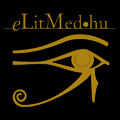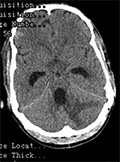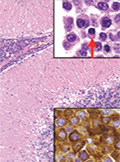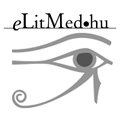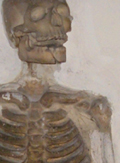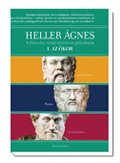The eLitMed.hu medical portal uses computer cookies for convenient operation. Detailed information can be found in the Cookie-policy.
Lege Artis Medicinae - 2016;26(05-06)
Content
[Organic and non-organic perspectives in feeding and eating disorders under three years of age]
[Providing optimal nutrition to infants and toddlers is a critical issue for both parents and experts. Besides the quality and quantity of food, indications of feeding behaviour such as feeding method and acceptance by the child are also crucial when determining feeding issues. The development of self-feeding is a significant part of the healthy somatomental development of a toddler between the age of 0-3 years. Efficient treatment of infants and toddlers with feeding disorders is often challenging in clinical practice. These symptoms frequently appear together with additional behaviour disorders, therefore functional reasons have to be taken into consideration in such cases. Due to the complexity of manifestations, applying tools beyond medical competence and involvement of special related professions are necessary. The general diagnostic systems of BNO-10 (International Classification of Diseases) and DSM-V (Statistical Manual of Mental Disorders) which are also applied in our country cannot be used appropriately for clear classification of early childhood feeding disorders and for examination of their backgrounds. DC:0-3R (Diagnostic Classification of Mental Health and Developmental Disorders of Infancy and Early Childhood- Zero to Three), generally used in Anglo-Saxon countries, can be considered as a complex diagnostic system. Using the DC:0-3R classification system (1), we will present six types of feeding disorders affecting children between the age of 0-36 months in which organic and functional origins have been examined as well. In our article we argue for the complex, psychosomatic interpretation and treatments of early childhood feeding disorders.]
[The role and scope of screening and diagnosing obstructive sleep apnea syndrome by the family physician]
[Diagnosis and treatment of sleep disorders play an increasingly important role in everyday clinical practice of family physicians. Obstructive sleep apnea syndrome (OSAS) is a significant disorder of this disease group due to its relatively high incidence rate and increasing risk of adverse medical outcomes in the course of time. The prevalence of OSAS is 2-4% in the general population. It is characterized by obstructive apneas and hypopneas mostly with desaturations and/or arousals caused by the repetitive collapse of the upper airway during sleep. Besides impairing sleep efficacy and daytime neurocognitive functions, OSAS increases cardiovascular risk as well. The typical clinical presentation is an excessive daytime sleepiness and loud snoring interrupted by brief pauses of breathing. It can be a risk factor for treatment-resistant and/or non-dipper hypertension, nocturnal cardiac arrhythmias, stroke, cognitive decline and depression. The importance of OSAS is presented by the fact that - according to the latest related Hungarian law reforms - risk evaluation of the disorder is part of the medical assessment of suitability for a driving license. The family physician’s tasks are to recognize the clinical symptoms, identify high-risk patients with potential complications who need adequate treatment and eventually guide them to sleep-diagnostic centers. ]
[Changes of diabetes deaths in Hungary from 2000 to 2009]
[INTRODUCTION - Official mortality statistics underestimate the etiological role of diabetes in mortality. METHODS - With the use of attributable risk ratio we estimated the proportion of total mortality and mortality under age 65 years due to diabetes in Hungary in 2000-2009. We corrected the analysis for the co-occurrence of diabetes and hypertension. The prevalence figures of diabetes were taken from the National Health Interview Surveys 2000, 2003 and 2009; the relative mortality figures in patients with diabetes from the Canadian Chronic Disease Surveillance System of the Public Health Agency Canada; and the Hungarian age-, and sex-specific mortality figures from the Demographic Yearbooks of the Central Statistical Office. RESULTS - The total mortality decreased by 15%, mortality under age 65 years by 16% in the studied period in Hungary. Meanwhile diabetes attributable mortality corrected for hypertension decreased by only 6%, premature mortality increased by 4%. As a consequence, the proportion of diabetes attributable mortality within total mortality increased from 4.6% to 5%, premature mortality from 4.3% to 5.5% by 2009, as the prevalence of diabetes increased from 6.9% in 2000 to 8.2% in 2009. Diabetes attributable mortality is approximately 2.5 times higher than the figures in the official mortality statistics. CONCLUSION - Diabetes and its main risk factors, overweight and obesity due to unhealthy diet and physical inactivity are one of the most important public health challenges nowadays. The burden of diabetes and its complications is already enormous. Mortality attributable to diabetes is much higher than it is reflected in the official mortality statistics. ]
[End state AIDS patient at an intensive care unit - a case report with unconventional lessons]
[A 26 year old male patient with unknown medical background had been admitted at the Department of Anestesiology and Intensive Therapy of the Jávorszky Ödön Hospital in the city of Vác. His HIV positivity had been revealed only at the 8th day of his hospitalization. He was living in a small settlement as an i.v. drug user, unknown to the drug prevention system or the STD primary care providing network. Being an end state AIDS patient, the time of the infection, the number of his contact persons, the source of the infection and the previous epidemiological pathway were not known. With this case report we would like to call attention to the importance of the differential diagnosis of AIDS disease, the role of the proper safety regulations concerning potentially infected and infected persons, the epidemiological importance of undiagnosed infections, and the extension of drug prevention services reachable for all persons in need. ]
[Neurological symptoms in a patient with treated multiple myeloma]
[INTRODUCTION - Meningeal infiltration by multiple myeloma is rare. Its incidence among cases of multiple myeloma is 1%. CASE REPORT - Multiple myeloma was diagnosed in a 53-year-old woman in December 2014. After chemotherapy, the disease was treated with autologous bone marrow transplantation in June 2015. Remission was observed through two months, but in August the patient was hospitalized due to severe headache with neck stiffness. Meningitis or viral encephalitis were suspected following her investigation. She was taken to the Intensive Care Unit because of a progression to status epilepticus. The EEG-examination revealed generalized slow wave activity and a right temporal epileptiform focus manifesting rarely. Clinical brain death developed on the 17th day in hospital. DISCUSSION - Although meningeal infiltration is infrequent in multiple myeloma, the present case report draws attention to this possibility. ]
[Current topics in modern health informatics]
[Development in technology - significant improvement in calculatory and storage capacities of computers - enable such calculation- and data-intensive applications, which were merely theoretical possibilities, even just a decade ago. Selected fields and methods of medical informatics are discussed in the article. Informatics methods became by now essential to biomedical research, drug discovery and development, and healthcare. Furthermore, the article presents a modern mobile information source application, developed in Hungary, which is aimed at supporting the activities and know-how of professionals in drug development and clinical research.]
[Music therapy in hospice care]
[The study gives a short review of some music therapy methods can be applied on the field of hospice care. Its aim is drawing the attention to the topic and enhancement of the method in the hospice movement in Hungary. The results of research works support the idea of applying both active and receptive music therapy for ensuring advantageous results in high quality care provided for dying patients. Properly chosen musical interventions applied by qualified music therapists within a therapeutic relationship are able to improve amongst others the quality of life of dying people by ensuring their inner peace, reducing the feeling of pain and anxiety and supporting their psychical-spiritual development. Besides the dying patients, hospice workers and the relatives of the patients can also experience the benefits of music therapy. ]
1.
Clinical Neuroscience
[Headache registry in Szeged: Experiences regarding to migraine patients]2.
Clinical Neuroscience
[The new target population of stroke awareness campaign: Kindergarten students ]3.
Clinical Neuroscience
Is there any difference in mortality rates of atrial fibrillation detected before or after ischemic stroke?4.
Clinical Neuroscience
Factors influencing the level of stigma in Parkinson’s disease in western Turkey5.
Clinical Neuroscience
[The effects of demographic and clinical factors on the severity of poststroke aphasia]1.
2.
Clinical Oncology
[Pancreatic cancer: ESMO Clinical Practice Guideline for diagnosis, treatment and follow-up]3.
Clinical Oncology
[Pharmacovigilance landscape – Lessons from the past and opportunities for future]4.
5.




